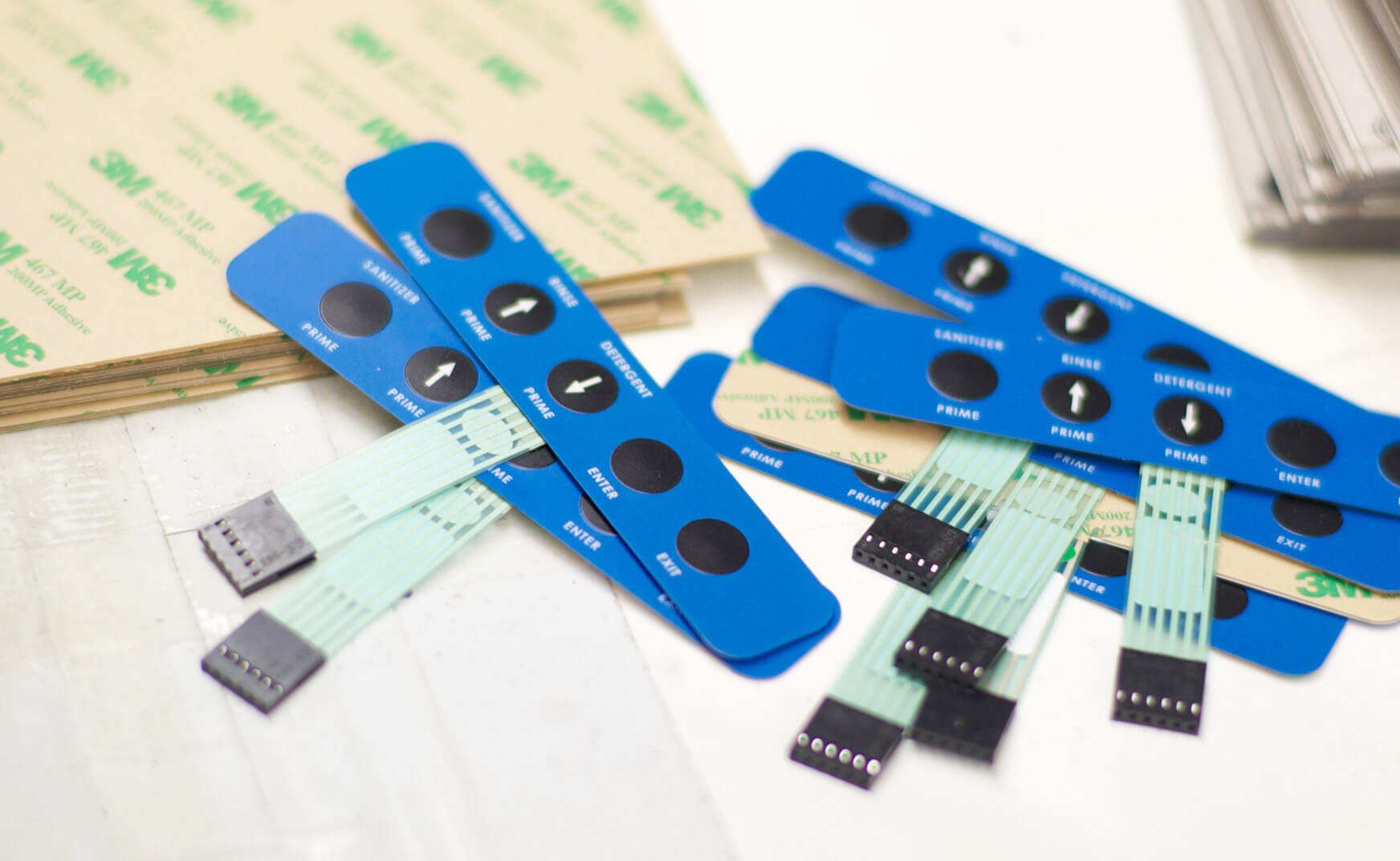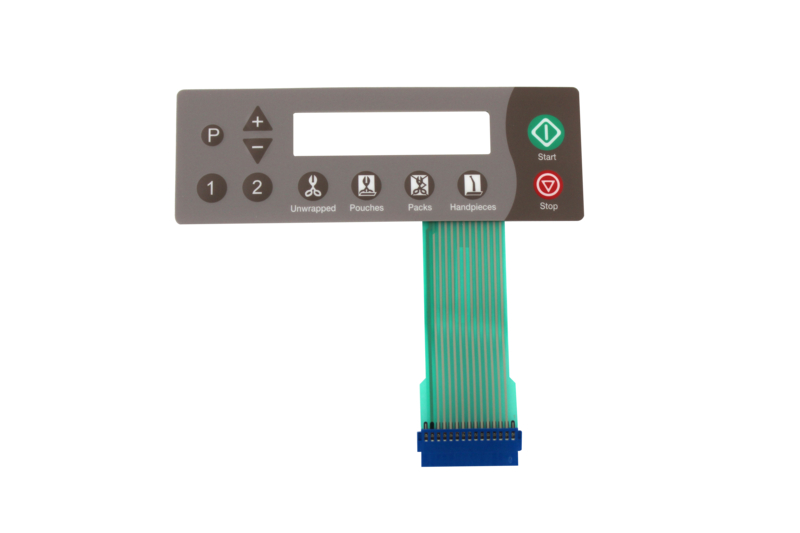Don’t ignore the value of working with a trustworthy membrane switch manufacturer for initial builds.
Don’t ignore the value of working with a trustworthy membrane switch manufacturer for initial builds.
Blog Article
All Regarding Membrane Layer Switch Over: Understanding Its Layout and Performance
When you assume concerning the control user interfaces in modern gadgets, membrane buttons typically come to mind. Allow's discover what collections membrane layer changes apart from various other control systems.
What Are Membrane Switches?

Their seamless nature makes them easy to clean and resistant to dust and dampness, an important feature in several settings. Membrane layer switches can additionally be customized regarding shape, size, and graphics, enabling makers to create distinct user interfaces customized to particular products. And also, they're light-weight and slim, which assists in reducing the general bulk of gadgets. Overall, membrane layer switches play a considerable function in boosting customer experience across a broad variety of applications.
How Membrane Layer Changes Job
When you push a secret on a membrane button, it triggers a straightforward yet efficient mechanism. membrane switch manufacturer. The leading layer, frequently made of adaptable material, presses down onto a conductive layer under it.
You'll discover that the responsive feedback differs based upon the switch style, offering either a soft click or an extra obvious action. As soon as you release the key, the membrane layer returns to its original position, resuming the circuit and stopping the signal. This process takes place practically instantly, making sure a receptive user experience.
Membrane switches are preferred due to their toughness and resistance to dust and dampness, making them ideal for different applications, from home devices to clinical tools. Recognizing this operation assists you appreciate their extensive usage.
Trick Parts of Membrane Layer Buttons
Recognizing the vital parts of membrane buttons is basic for grasping their performance and style. At the core, you'll discover the graphic overlay, which provides the visual interface for individuals. Below that, there's a spacer layer that separates the circuit layers, making certain that they do not make call till pushed. The circuit layer is where the magic occurs; it includes conductive traces that finish the circuit when you press the button. One more important component is the sticky support, permitting the switch to comply with surfaces safely. Ultimately, the safety layer guards against environmental elements and wear, expanding the switch's life-span. Each component plays a substantial function in ensuring trusted performance and user interaction. By comprehending these elements, you'll get insight right into just how membrane switches run and their significance in numerous applications.
Products Used in Membrane Layer Change Design
The performance and resilience of membrane layer switches over greatly depend upon the products made use of in their design. You generally run into polyester and polycarbonate as key substrates due to their excellent toughness and flexibility. These materials stand up to scratches and chemicals, making them excellent for demanding atmospheres.
The conductive layers frequently use silver or carbon, selected for their dependability and conductivity. membrane switch manufacturer. Silver gives remarkable performance, while carbon is an economical option. For the overlay, you might think about a matte or glossy surface, depending upon your visual requirements and user experience
Adhesives play a vital duty also; they bond layers safely and ensure longevity. Make specific to pick adhesives that withstand environmental factors like temperature and humidity. Do not ignore the significance of an excellent printing method for graphics, as it boosts both functionality advice and aesthetic appeal. Picking the appropriate products will assure your membrane switch stands the test of time.
Design Factors To Consider for Membrane Buttons
While designing membrane switches, it's essential to consider various aspects that affect their performance and individual experience. Begin by concentrating on the design and switch dimension; make sure they're instinctive and easy to navigate. Take into consideration the tactile feedback you desire to supply-- will customers require a noticeable click or a softer touch? Furthermore, think of the products you'll utilize, as they'll influence resilience and aesthetics.
Do not ignore the graphic design; clear labeling and shade comparison are substantial for visibility. Confirm your layout suits environmental variables, like wetness or temperature variations, which might affect performance. Bear in mind the importance of screening models with actual individuals to collect responses and make necessary adjustments. This repetitive process aids you refine the layout, verifying it fulfills both useful and visual demands properly. By very carefully taking into consideration these aspects, you'll develop a membrane switch that boosts use and satisfaction.
Applications of Membrane Buttons
Membrane switches are functional elements found in different applications, from commercial devices to consumer electronic devices. You'll see their influence in equipments that require resilient user interfaces and in devices that benefit from smooth designs. Understanding these applications assists you appreciate the performance and functionality of membrane buttons in everyday modern technology.
Industrial Devices Use
When you're looking to improve the functionality of commercial devices, membrane buttons offer a reliable option that integrates durability with straightforward style. These buttons are ideal for severe atmospheres, giving resistance to dust, dampness, and chemicals. You'll discover them in control panels for making devices, HVAC systems, and medical tools, where precision and responsiveness are essential. Their low profile indicates they fit perfectly into various equipment, conserving useful area while keeping convenience of usage. With adjustable graphics and backlighting alternatives, you can produce an intuitive user interface for operators, enhancing performance and safety and security. Plus, their lengthy life-span reduces upkeep costs, making them a smart financial investment for your commercial applications. Welcome membrane layer buttons to streamline your procedures and improve general performance.
Consumer Electronics Integration
In the domain of consumer electronics, membrane layer buttons play an important function in enhancing user interaction and device performance. You'll find them in gadgets like microwaves, remotes, and gaming consoles, providing a seamless method to interact with technology. Their smooth layout allows for very easy combination into various products, making controls instinctive and user-friendly. have a peek here With their ability to include graphics and backlighting, you can take pleasure in a modern-day aesthetic that complements the gadget's total appearance. Membrane buttons likewise guarantee longevity and read more resistance to dirt and wetness, extending the life expectancy of your electronics. By picking membrane switches, you enhance not just the capability however also the design of your devices, making day-to-day communications smooth and satisfying.
Advantages and Drawbacks of Membrane Switches
While membrane layer buttons use a range of benefits, they also come with some downsides that you ought to consider. One considerable advantage is their small design, making them perfect for space-constrained applications.

Membrane layer switches can have a shorter lifespan contrasted to mechanical buttons, especially under heavy use. They can also be less tactile, which might impact customer responses during operation. Balancing these pros and cons will certainly help you figure out if membrane layer switches are the right fit for your task.
Frequently Asked Inquiries
The Length Of Time Do Membrane Layer Switches Generally Last?
Membrane layer switches commonly last between 5 to 10 years, depending on use and environmental conditions. You'll want to evaluate aspects like wear, exposure to dampness, and temperature level changes to determine their longevity effectively.
Can Membrane Switches Be Custom-made for Particular Styles?
Yes, you can personalize membrane layer buttons to fit specific designs (membrane switch manufacturer). You'll have the freedom to choose colors, shapes, and designs that match your task's demands, ensuring they blend seamlessly with your general aesthetic
What Is the Cost Variety for Membrane Layer Change Manufacturing?
The price range for membrane layer button manufacturing usually drops in between $1 and $10 each, relying on variables like design complexity, amount, and materials. You can obtain quotes from makers to locate the most effective choice.

Are Membrane Layer Switches Water Resistant or Resistant?
Membrane layer switches can be developed to be water-proof or resistant, depending upon products utilized and building and construction techniques. If you require them for damp settings, assure you define those demands during the design procedure.
Exactly How Do Membrane Switches Over Contrast to Traditional Buttons?
Membrane layer buttons are generally thinner and a lot more versatile than conventional buttons, providing a streamlined layout. They're typically less complicated to clean up and integrate, but could not offer the responsive responses you're utilized to with mechanical choices.
Final thought

Report this page